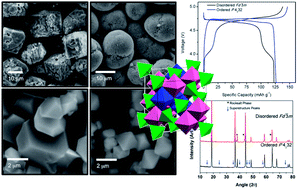A perspective on the high-voltage LiMn1.5Ni0.5O4 spinel cathode for lithium-ion batteries
Abstract
The LiMn1.5Ni0.5O4 spinel is an attractive cathode candidate for next generation lithium-ion batteries as it offers high power capability with an operating voltage of ∼4.7 V and a capacity of ∼135 mA h g−1. However, its commercialization is plagued by severe capacity fade, particularly at elevated temperatures, in full cells employing a graphite anode. This perspective article provides an overview of the recent developments on understanding various factors that influence the electrochemical performance of the high-voltage spinel cathodes. The factors include the degree of cation ordering, Mn3+ content, morphology, and surface planes/compositions in contact with the electrolyte, which are influenced by synthesis and annealing conditions as well as cation doping. For example, samples with a {111} family of surface planes show superior performance. Recent magnetic measurements and examination of discharge profiles below 3 V have become valuable to get a more precise measure of the degree of cation ordering. Also, surface modifications and electrolyte additives have shown marginal gains. Although acceptable performances have been obtained in half-cells with a metallic lithium anode, capacity fade is seen in full cells with a graphite anode due to metal dissolution at the high operating voltage of 4.7 V and Li+ consumption by the steadily forming solid–electrolyte interphase (SEI) layer promoted by Mn/Ni deposition on the graphite surface. Based on the current understanding, future directions are pointed out.

- This article is part of the themed collection: Electrochemical Energy Storage & Conversion

 Please wait while we load your content...
Please wait while we load your content...